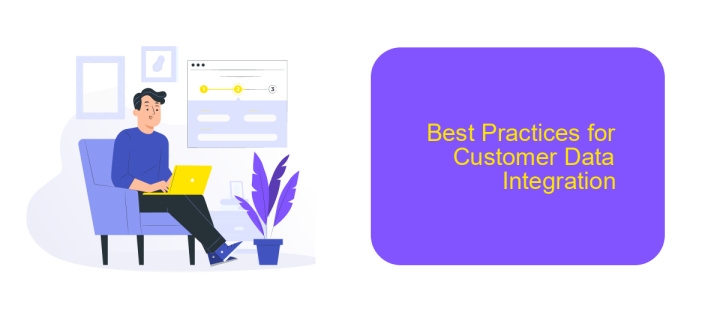Customer Data Integration Best Practices
In today's data-driven world, integrating customer data effectively is crucial for businesses aiming to enhance customer experience and drive growth. This article explores best practices for customer data integration, focusing on strategies that ensure data accuracy, consistency, and accessibility. By implementing these practices, organizations can unlock valuable insights, streamline operations, and foster stronger customer relationships.
Introduction
Customer Data Integration (CDI) is a critical process for businesses aiming to consolidate customer information from various sources into a single, unified view. This integration enables companies to enhance customer experience, improve decision-making, and streamline operations.
- Ensure data accuracy and consistency across all platforms.
- Utilize reliable integration tools like ApiX-Drive for seamless data synchronization.
- Implement robust security measures to protect sensitive customer information.
- Regularly update and maintain integrated systems to prevent data discrepancies.
Effective CDI practices not only foster better customer relationships but also drive business growth by providing actionable insights. Leveraging services like ApiX-Drive can simplify the integration process, ensuring that data flows smoothly between systems and remains up-to-date. By prioritizing data integration, businesses can stay competitive and responsive to customer needs.
Benefits of Customer Data Integration

Integrating customer data offers a multitude of benefits that can significantly enhance business operations. By consolidating data from various touchpoints, companies gain a comprehensive view of their customers, enabling more accurate and personalized marketing strategies. This holistic approach not only improves customer satisfaction but also drives higher conversion rates and loyalty. Additionally, streamlined data integration minimizes the risk of data silos, ensuring that all departments have access to consistent and up-to-date information, which in turn enhances decision-making processes.
Utilizing services like ApiX-Drive can further optimize the integration process. ApiX-Drive simplifies the connection of different data sources, automating the flow of information between various platforms without the need for extensive technical expertise. This not only saves time and resources but also reduces the likelihood of errors that can occur with manual data handling. By leveraging such tools, businesses can maintain a seamless and efficient data integration system, ultimately fostering a more agile and responsive organizational structure.
Challenges of Customer Data Integration

Customer data integration (CDI) poses several challenges that businesses must navigate to ensure seamless data flow and accuracy. These challenges can significantly impact the efficiency and effectiveness of data management processes.
- Data Silos: Different departments often store data in isolated systems, making it difficult to consolidate and analyze customer information comprehensively.
- Data Quality: Inconsistent and inaccurate data from various sources can lead to poor decision-making and customer dissatisfaction.
- Integration Complexity: Integrating data from multiple platforms and formats requires sophisticated tools and expertise, which can be resource-intensive.
- Privacy and Compliance: Adhering to regulations such as GDPR and CCPA while integrating customer data is essential to avoid legal repercussions.
- Scalability: As businesses grow, their data integration solutions must scale accordingly to handle increasing volumes of customer data.
To address these challenges, businesses can leverage tools like ApiX-Drive, which facilitate seamless data integration across various platforms. ApiX-Drive offers automated workflows that reduce manual intervention, ensuring data consistency and accuracy while complying with privacy regulations. By utilizing such services, companies can enhance their data integration processes and ultimately improve customer experience.
Best Practices for Customer Data Integration

Effective customer data integration (CDI) is crucial for businesses aiming to deliver personalized experiences and make data-driven decisions. To achieve this, companies must follow a set of best practices that ensure data accuracy, consistency, and security. Implementing these practices can help in seamlessly integrating data from various sources and improving overall customer insights.
One of the first steps in CDI is to establish a clear strategy that outlines the goals, processes, and technologies involved. This strategy should be aligned with the organization's objectives and consider the specific needs of different departments. Additionally, leveraging robust integration platforms like ApiX-Drive can simplify the process by automating data synchronization across multiple systems.
- Ensure data quality by regularly cleansing and validating customer information.
- Use standardized formats and protocols for data exchange to maintain consistency.
- Implement strong security measures to protect sensitive customer data.
- Continuously monitor and update integration processes to adapt to changing business needs.
By adhering to these best practices, organizations can enhance their customer data integration efforts, leading to more accurate insights and better customer experiences. Utilizing tools like ApiX-Drive can further streamline the integration process, allowing businesses to focus on leveraging data for strategic growth.
Conclusion
In conclusion, implementing best practices for customer data integration is essential for businesses aiming to streamline operations and enhance customer experiences. By adopting a strategic approach, organizations can ensure data accuracy, consistency, and accessibility across all platforms. This not only aids in better decision-making but also fosters stronger customer relationships by providing a unified view of customer interactions.
Tools like ApiX-Drive can significantly simplify the integration process, allowing businesses to seamlessly connect various data sources and automate workflows. Leveraging such services ensures that data is synchronized in real-time, reducing manual effort and the risk of errors. Ultimately, a well-executed customer data integration strategy empowers businesses to stay competitive in today’s data-driven landscape, driving growth and innovation.
FAQ
What is Customer Data Integration (CDI)?
Why is CDI important for businesses?
What are some best practices for CDI?
How can businesses automate the CDI process?
What challenges might businesses face with CDI?
Time is the most valuable resource for business today. Almost half of it is wasted on routine tasks. Your employees are constantly forced to perform monotonous tasks that are difficult to classify as important and specialized. You can leave everything as it is by hiring additional employees, or you can automate most of the business processes using the ApiX-Drive online connector to get rid of unnecessary time and money expenses once and for all. The choice is yours!

